sensor FORD E-350 2021 Owner's Manual
[x] Cancel search | Manufacturer: FORD, Model Year: 2021, Model line: E-350, Model: FORD E-350 2021Pages: 301, PDF Size: 3.83 MB
Page 209 of 301
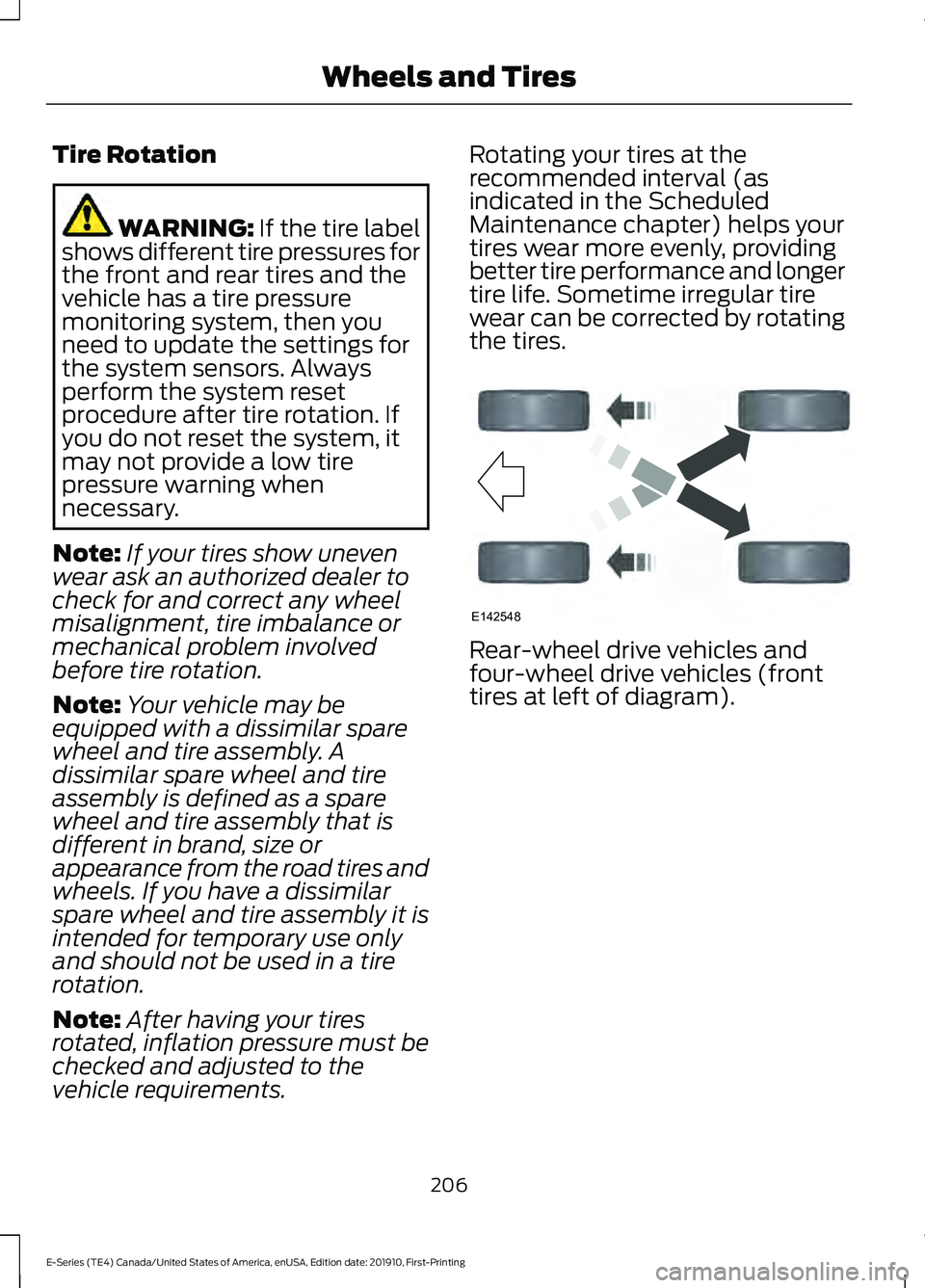
Tire Rotation
WARNING: If the tire label
shows different tire pressures for
the front and rear tires and the
vehicle has a tire pressure
monitoring system, then you
need to update the settings for
the system sensors. Always
perform the system reset
procedure after tire rotation. If
you do not reset the system, it
may not provide a low tire
pressure warning when
necessary.
Note: If your tires show uneven
wear ask an authorized dealer to
check for and correct any wheel
misalignment, tire imbalance or
mechanical problem involved
before tire rotation.
Note: Your vehicle may be
equipped with a dissimilar spare
wheel and tire assembly. A
dissimilar spare wheel and tire
assembly is defined as a spare
wheel and tire assembly that is
different in brand, size or
appearance from the road tires and
wheels. If you have a dissimilar
spare wheel and tire assembly it is
intended for temporary use only
and should not be used in a tire
rotation.
Note: After having your tires
rotated, inflation pressure must be
checked and adjusted to the
vehicle requirements. Rotating your tires at the
recommended interval (as
indicated in the Scheduled
Maintenance chapter) helps your
tires wear more evenly, providing
better tire performance and longer
tire life. Sometime irregular tire
wear can be corrected by rotating
the tires.
Rear-wheel drive vehicles and
four-wheel drive vehicles (front
tires at left of diagram).
206
E-Series (TE4) Canada/United States of America, enUSA, Edition date: 201910, First-Printing Wheels and TiresE142548
Page 211 of 301
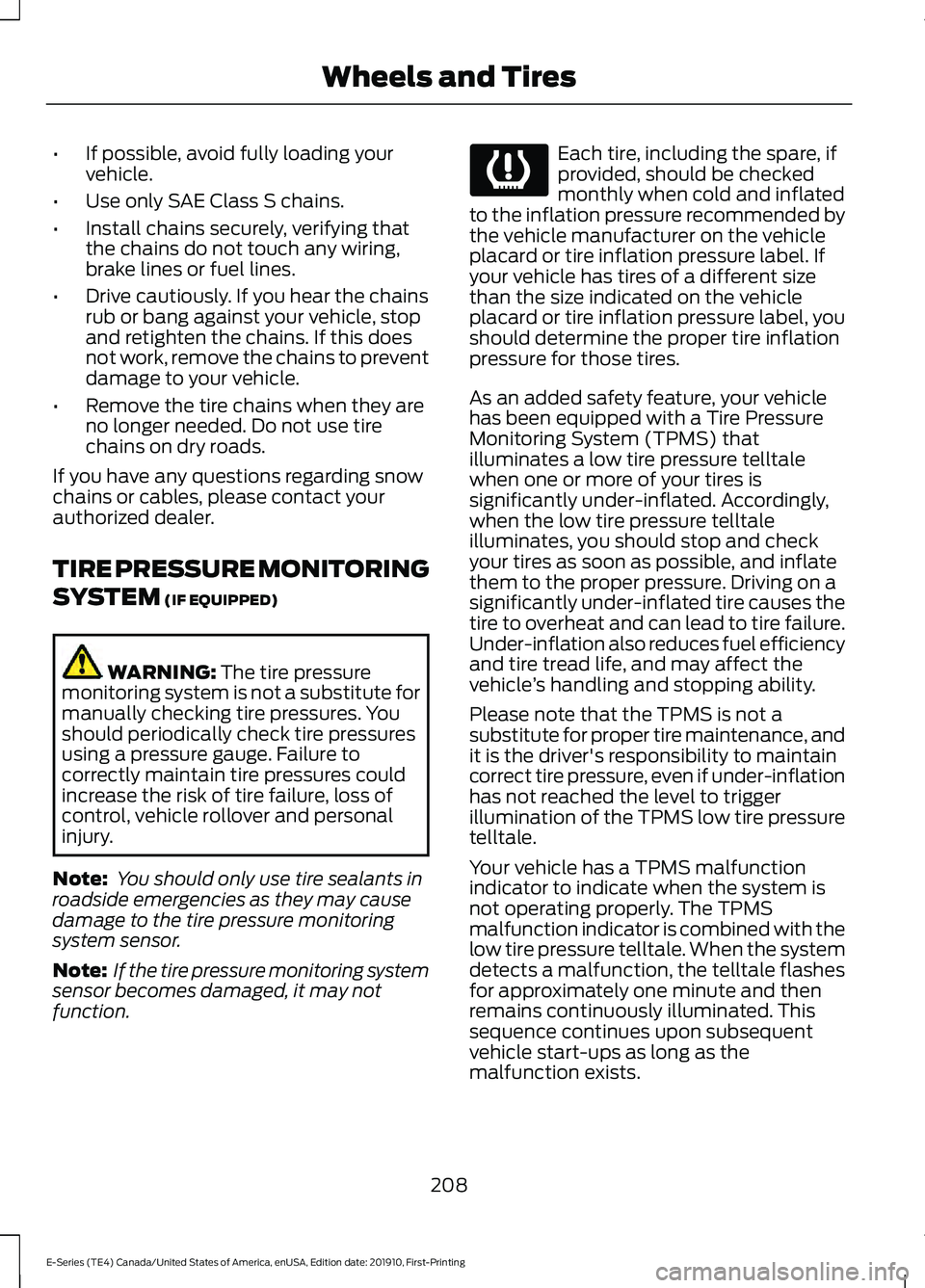
•
If possible, avoid fully loading your
vehicle.
• Use only SAE Class S chains.
• Install chains securely, verifying that
the chains do not touch any wiring,
brake lines or fuel lines.
• Drive cautiously. If you hear the chains
rub or bang against your vehicle, stop
and retighten the chains. If this does
not work, remove the chains to prevent
damage to your vehicle.
• Remove the tire chains when they are
no longer needed. Do not use tire
chains on dry roads.
If you have any questions regarding snow
chains or cables, please contact your
authorized dealer.
TIRE PRESSURE MONITORING
SYSTEM (IF EQUIPPED) WARNING:
The tire pressure
monitoring system is not a substitute for
manually checking tire pressures. You
should periodically check tire pressures
using a pressure gauge. Failure to
correctly maintain tire pressures could
increase the risk of tire failure, loss of
control, vehicle rollover and personal
injury.
Note: You should only use tire sealants in
roadside emergencies as they may cause
damage to the tire pressure monitoring
system sensor.
Note: If the tire pressure monitoring system
sensor becomes damaged, it may not
function. Each tire, including the spare, if
provided, should be checked
monthly when cold and inflated
to the inflation pressure recommended by
the vehicle manufacturer on the vehicle
placard or tire inflation pressure label. If
your vehicle has tires of a different size
than the size indicated on the vehicle
placard or tire inflation pressure label, you
should determine the proper tire inflation
pressure for those tires.
As an added safety feature, your vehicle
has been equipped with a Tire Pressure
Monitoring System (TPMS) that
illuminates a low tire pressure telltale
when one or more of your tires is
significantly under-inflated. Accordingly,
when the low tire pressure telltale
illuminates, you should stop and check
your tires as soon as possible, and inflate
them to the proper pressure. Driving on a
significantly under-inflated tire causes the
tire to overheat and can lead to tire failure.
Under-inflation also reduces fuel efficiency
and tire tread life, and may affect the
vehicle ’s handling and stopping ability.
Please note that the TPMS is not a
substitute for proper tire maintenance, and
it is the driver's responsibility to maintain
correct tire pressure, even if under-inflation
has not reached the level to trigger
illumination of the TPMS low tire pressure
telltale.
Your vehicle has a TPMS malfunction
indicator to indicate when the system is
not operating properly. The TPMS
malfunction indicator is combined with the
low tire pressure telltale. When the system
detects a malfunction, the telltale flashes
for approximately one minute and then
remains continuously illuminated. This
sequence continues upon subsequent
vehicle start-ups as long as the
malfunction exists.
208
E-Series (TE4) Canada/United States of America, enUSA, Edition date: 201910, First-Printing Wheels and Tires
Page 212 of 301
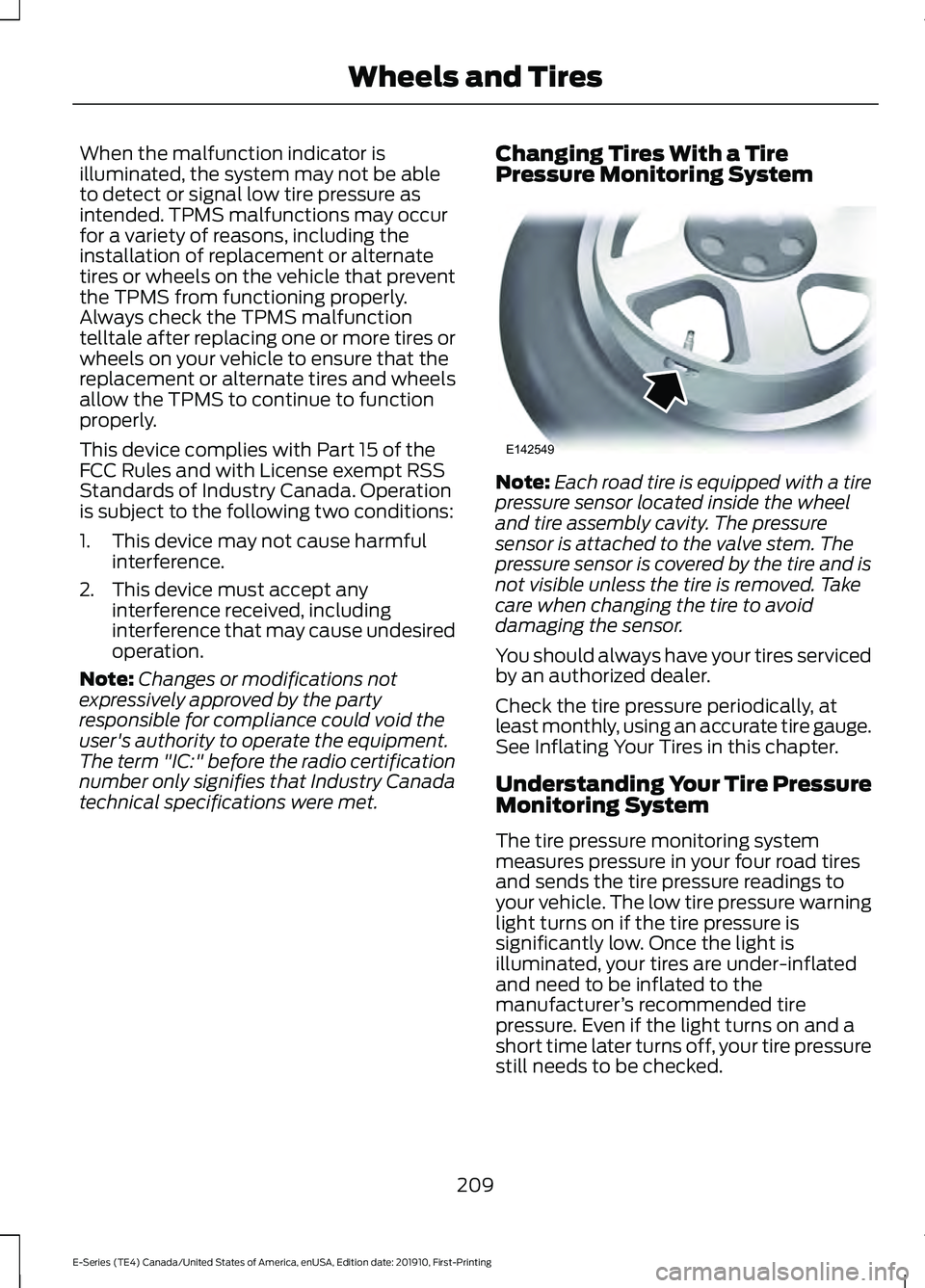
When the malfunction indicator is
illuminated, the system may not be able
to detect or signal low tire pressure as
intended. TPMS malfunctions may occur
for a variety of reasons, including the
installation of replacement or alternate
tires or wheels on the vehicle that prevent
the TPMS from functioning properly.
Always check the TPMS malfunction
telltale after replacing one or more tires or
wheels on your vehicle to ensure that the
replacement or alternate tires and wheels
allow the TPMS to continue to function
properly.
This device complies with Part 15 of the
FCC Rules and with License exempt RSS
Standards of Industry Canada. Operation
is subject to the following two conditions:
1. This device may not cause harmful
interference.
2. This device must accept any interference received, including
interference that may cause undesired
operation.
Note: Changes or modifications not
expressively approved by the party
responsible for compliance could void the
user's authority to operate the equipment.
The term "IC:" before the radio certification
number only signifies that Industry Canada
technical specifications were met. Changing Tires With a Tire
Pressure Monitoring System Note:
Each road tire is equipped with a tire
pressure sensor located inside the wheel
and tire assembly cavity. The pressure
sensor is attached to the valve stem. The
pressure sensor is covered by the tire and is
not visible unless the tire is removed. Take
care when changing the tire to avoid
damaging the sensor.
You should always have your tires serviced
by an authorized dealer.
Check the tire pressure periodically, at
least monthly, using an accurate tire gauge.
See Inflating Your Tires in this chapter.
Understanding Your Tire Pressure
Monitoring System
The tire pressure monitoring system
measures pressure in your four road tires
and sends the tire pressure readings to
your vehicle. The low tire pressure warning
light turns on if the tire pressure is
significantly low. Once the light is
illuminated, your tires are under-inflated
and need to be inflated to the
manufacturer ’s recommended tire
pressure. Even if the light turns on and a
short time later turns off, your tire pressure
still needs to be checked.
209
E-Series (TE4) Canada/United States of America, enUSA, Edition date: 201910, First-Printing Wheels and TiresE142549
Page 215 of 301
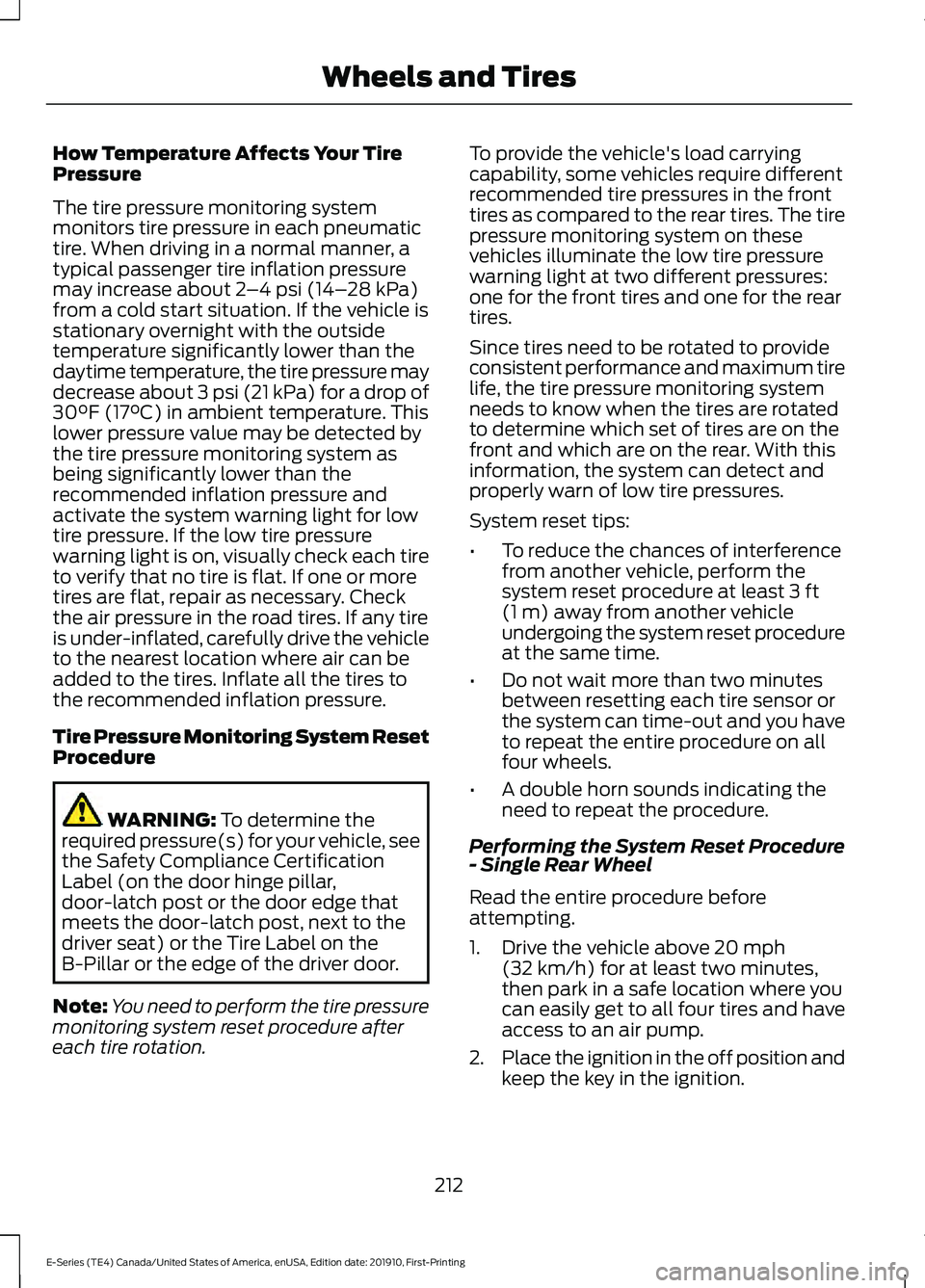
How Temperature Affects Your Tire
Pressure
The tire pressure monitoring system
monitors tire pressure in each pneumatic
tire. When driving in a normal manner, a
typical passenger tire inflation pressure
may increase about 2
–4 psi (14– 28 kPa)
from a cold start situation. If the vehicle is
stationary overnight with the outside
temperature significantly lower than the
daytime temperature, the tire pressure may
decrease about 3 psi (21 kPa) for a drop of
30°F (17°C) in ambient temperature. This
lower pressure value may be detected by
the tire pressure monitoring system as
being significantly lower than the
recommended inflation pressure and
activate the system warning light for low
tire pressure. If the low tire pressure
warning light is on, visually check each tire
to verify that no tire is flat. If one or more
tires are flat, repair as necessary. Check
the air pressure in the road tires. If any tire
is under-inflated, carefully drive the vehicle
to the nearest location where air can be
added to the tires. Inflate all the tires to
the recommended inflation pressure.
Tire Pressure Monitoring System Reset
Procedure WARNING:
To determine the
required pressure(s) for your vehicle, see
the Safety Compliance Certification
Label (on the door hinge pillar,
door-latch post or the door edge that
meets the door-latch post, next to the
driver seat) or the Tire Label on the
B-Pillar or the edge of the driver door.
Note: You need to perform the tire pressure
monitoring system reset procedure after
each tire rotation. To provide the vehicle's load carrying
capability, some vehicles require different
recommended tire pressures in the front
tires as compared to the rear tires. The tire
pressure monitoring system on these
vehicles illuminate the low tire pressure
warning light at two different pressures:
one for the front tires and one for the rear
tires.
Since tires need to be rotated to provide
consistent performance and maximum tire
life, the tire pressure monitoring system
needs to know when the tires are rotated
to determine which set of tires are on the
front and which are on the rear. With this
information, the system can detect and
properly warn of low tire pressures.
System reset tips:
•
To reduce the chances of interference
from another vehicle, perform the
system reset procedure at least
3 ft
(1 m) away from another vehicle
undergoing the system reset procedure
at the same time.
• Do not wait more than two minutes
between resetting each tire sensor or
the system can time-out and you have
to repeat the entire procedure on all
four wheels.
• A double horn sounds indicating the
need to repeat the procedure.
Performing the System Reset Procedure
- Single Rear Wheel
Read the entire procedure before
attempting.
1. Drive the vehicle above
20 mph
(32 km/h) for at least two minutes,
then park in a safe location where you
can easily get to all four tires and have
access to an air pump.
2. Place the ignition in the off position and
keep the key in the ignition.
212
E-Series (TE4) Canada/United States of America, enUSA, Edition date: 201910, First-Printing Wheels and Tires
Page 216 of 301
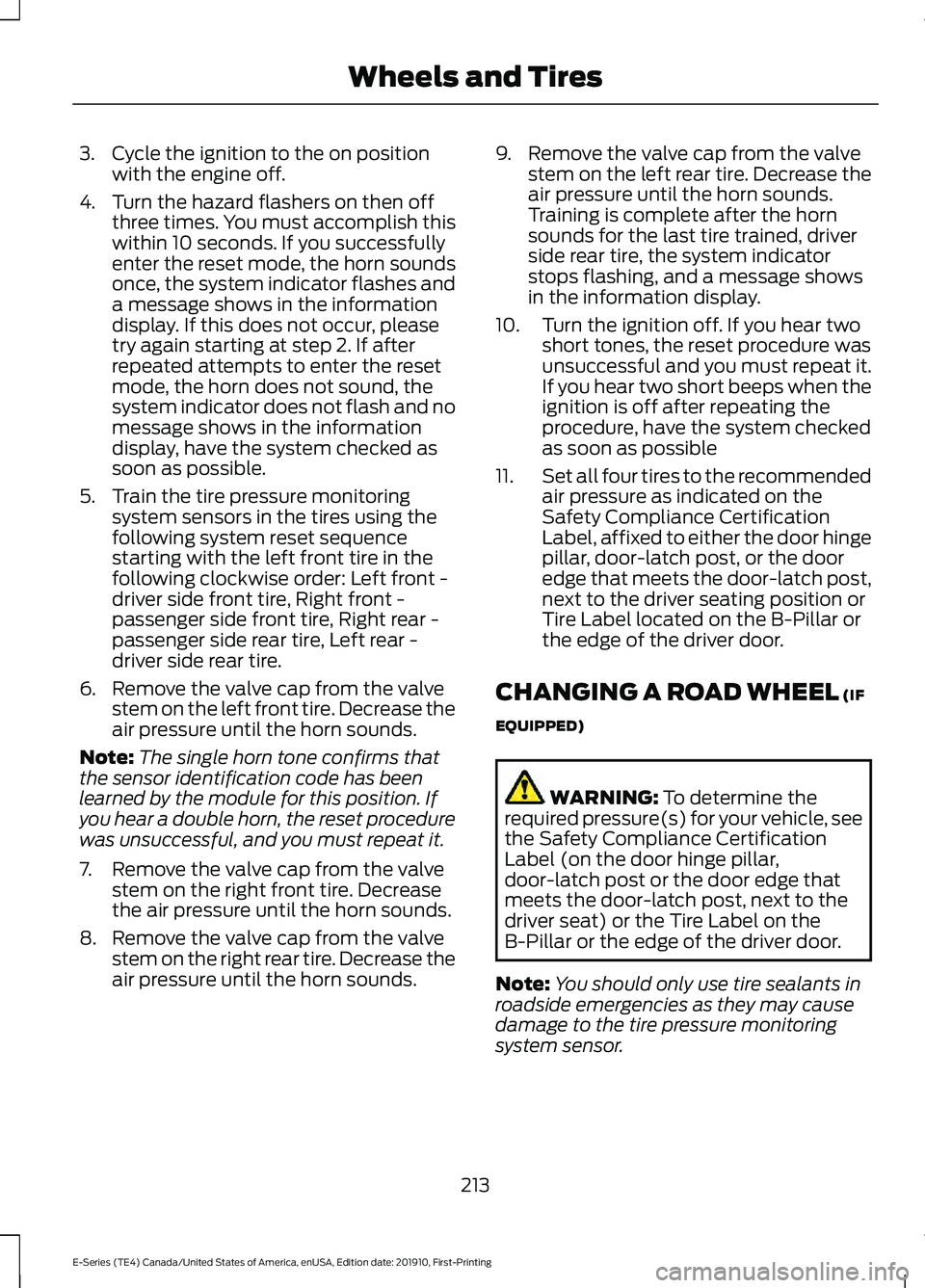
3. Cycle the ignition to the on position
with the engine off.
4. Turn the hazard flashers on then off three times. You must accomplish this
within 10 seconds. If you successfully
enter the reset mode, the horn sounds
once, the system indicator flashes and
a message shows in the information
display. If this does not occur, please
try again starting at step 2. If after
repeated attempts to enter the reset
mode, the horn does not sound, the
system indicator does not flash and no
message shows in the information
display, have the system checked as
soon as possible.
5. Train the tire pressure monitoring system sensors in the tires using the
following system reset sequence
starting with the left front tire in the
following clockwise order: Left front -
driver side front tire, Right front -
passenger side front tire, Right rear -
passenger side rear tire, Left rear -
driver side rear tire.
6. Remove the valve cap from the valve stem on the left front tire. Decrease the
air pressure until the horn sounds.
Note: The single horn tone confirms that
the sensor identification code has been
learned by the module for this position. If
you hear a double horn, the reset procedure
was unsuccessful, and you must repeat it.
7. Remove the valve cap from the valve stem on the right front tire. Decrease
the air pressure until the horn sounds.
8. Remove the valve cap from the valve stem on the right rear tire. Decrease the
air pressure until the horn sounds. 9. Remove the valve cap from the valve
stem on the left rear tire. Decrease the
air pressure until the horn sounds.
Training is complete after the horn
sounds for the last tire trained, driver
side rear tire, the system indicator
stops flashing, and a message shows
in the information display.
10. Turn the ignition off. If you hear two short tones, the reset procedure was
unsuccessful and you must repeat it.
If you hear two short beeps when the
ignition is off after repeating the
procedure, have the system checked
as soon as possible
11. Set all four tires to the recommended
air pressure as indicated on the
Safety Compliance Certification
Label, affixed to either the door hinge
pillar, door-latch post, or the door
edge that meets the door-latch post,
next to the driver seating position or
Tire Label located on the B-Pillar or
the edge of the driver door.
CHANGING A ROAD WHEEL (IF
EQUIPPED) WARNING:
To determine the
required pressure(s) for your vehicle, see
the Safety Compliance Certification
Label (on the door hinge pillar,
door-latch post or the door edge that
meets the door-latch post, next to the
driver seat) or the Tire Label on the
B-Pillar or the edge of the driver door.
Note: You should only use tire sealants in
roadside emergencies as they may cause
damage to the tire pressure monitoring
system sensor.
213
E-Series (TE4) Canada/United States of America, enUSA, Edition date: 201910, First-Printing Wheels and Tires
Page 217 of 301
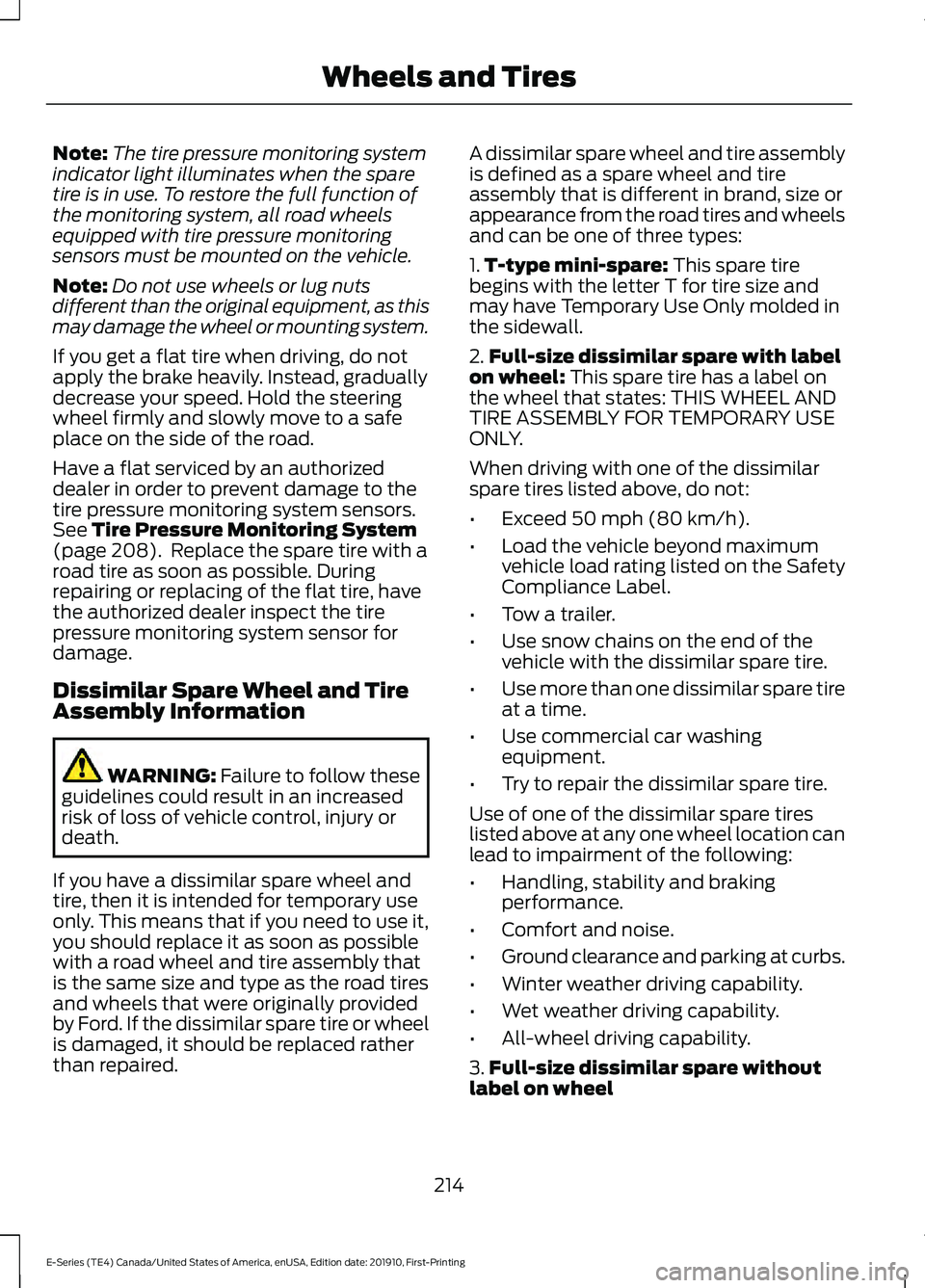
Note:
The tire pressure monitoring system
indicator light illuminates when the spare
tire is in use. To restore the full function of
the monitoring system, all road wheels
equipped with tire pressure monitoring
sensors must be mounted on the vehicle.
Note: Do not use wheels or lug nuts
different than the original equipment, as this
may damage the wheel or mounting system.
If you get a flat tire when driving, do not
apply the brake heavily. Instead, gradually
decrease your speed. Hold the steering
wheel firmly and slowly move to a safe
place on the side of the road.
Have a flat serviced by an authorized
dealer in order to prevent damage to the
tire pressure monitoring system sensors.
See Tire Pressure Monitoring System
(page 208). Replace the spare tire with a
road tire as soon as possible. During
repairing or replacing of the flat tire, have
the authorized dealer inspect the tire
pressure monitoring system sensor for
damage.
Dissimilar Spare Wheel and Tire
Assembly Information WARNING:
Failure to follow these
guidelines could result in an increased
risk of loss of vehicle control, injury or
death.
If you have a dissimilar spare wheel and
tire, then it is intended for temporary use
only. This means that if you need to use it,
you should replace it as soon as possible
with a road wheel and tire assembly that
is the same size and type as the road tires
and wheels that were originally provided
by Ford. If the dissimilar spare tire or wheel
is damaged, it should be replaced rather
than repaired. A dissimilar spare wheel and tire assembly
is defined as a spare wheel and tire
assembly that is different in brand, size or
appearance from the road tires and wheels
and can be one of three types:
1.
T-type mini-spare:
This spare tire
begins with the letter T for tire size and
may have Temporary Use Only molded in
the sidewall.
2. Full-size dissimilar spare with label
on wheel:
This spare tire has a label on
the wheel that states: THIS WHEEL AND
TIRE ASSEMBLY FOR TEMPORARY USE
ONLY.
When driving with one of the dissimilar
spare tires listed above, do not:
• Exceed
50 mph (80 km/h).
• Load the vehicle beyond maximum
vehicle load rating listed on the Safety
Compliance Label.
• Tow a trailer.
• Use snow chains on the end of the
vehicle with the dissimilar spare tire.
• Use more than one dissimilar spare tire
at a time.
• Use commercial car washing
equipment.
• Try to repair the dissimilar spare tire.
Use of one of the dissimilar spare tires
listed above at any one wheel location can
lead to impairment of the following:
• Handling, stability and braking
performance.
• Comfort and noise.
• Ground clearance and parking at curbs.
• Winter weather driving capability.
• Wet weather driving capability.
• All-wheel driving capability.
3. Full-size dissimilar spare without
label on wheel
214
E-Series (TE4) Canada/United States of America, enUSA, Edition date: 201910, First-Printing Wheels and Tires
Page 295 of 301
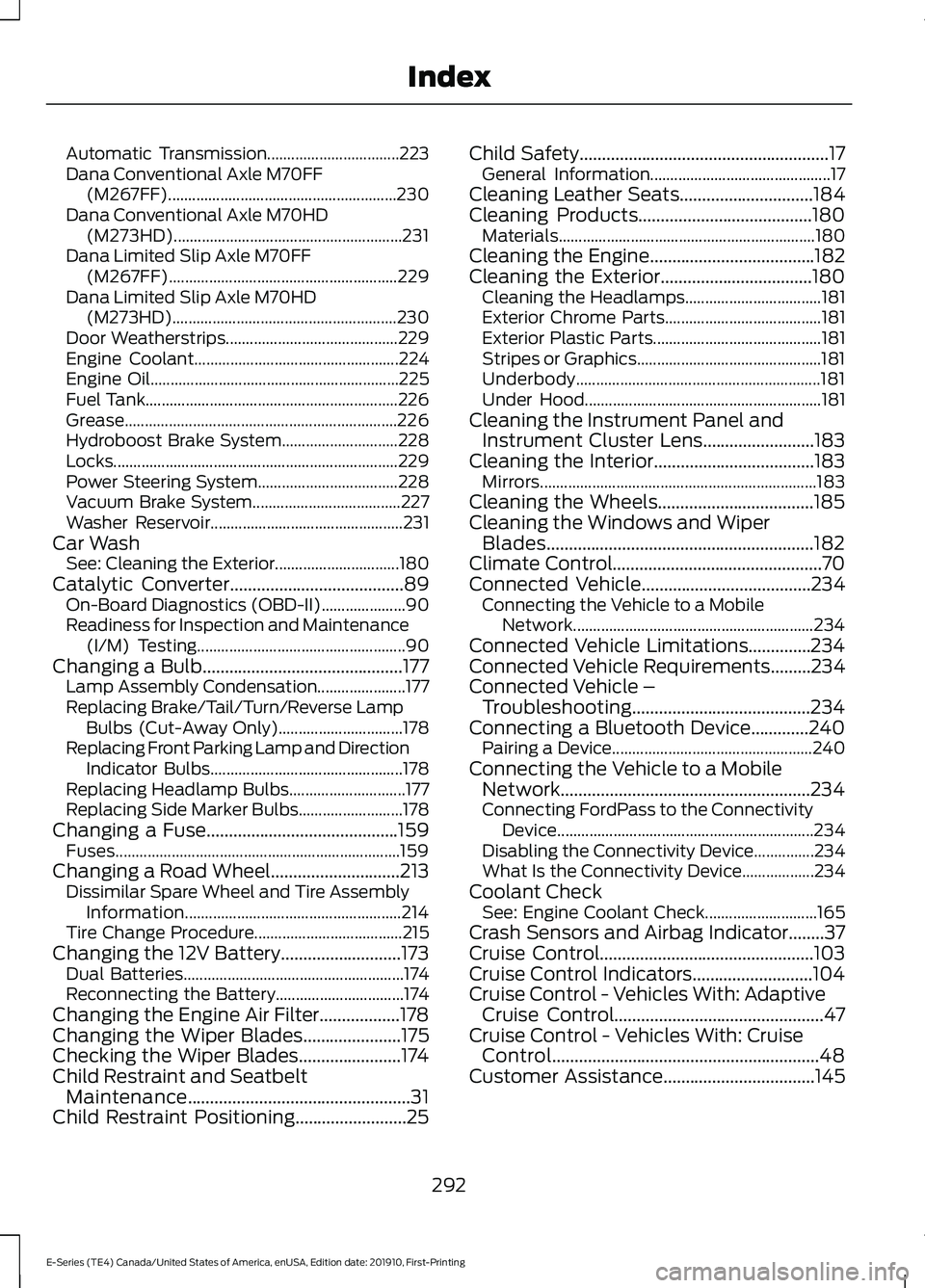
Automatic Transmission.................................
223
Dana Conventional Axle M70FF (M267FF)......................................................... 230
Dana Conventional Axle M70HD (M273HD)......................................................... 231
Dana Limited Slip Axle M70FF (M267FF)......................................................... 229
Dana Limited Slip Axle M70HD (M273HD)........................................................ 230
Door Weatherstrips........................................... 229
Engine Coolant................................................... 224
Engine Oil.............................................................. 225
Fuel Tank............................................................... 226
Grease.................................................................... 226
Hydroboost Brake System............................. 228
Locks....................................................................... 229
Power Steering System................................... 228
Vacuum Brake System..................................... 227
Washer Reservoir................................................ 231
Car Wash See: Cleaning the Exterior............................... 180
Catalytic Converter.......................................89
On-Board Diagnostics (OBD-II)..................... 90
Readiness for Inspection and Maintenance (I/M) Testing.................................................... 90
Changing a Bulb
.............................................177
Lamp Assembly Condensation...................... 177
Replacing Brake/Tail/Turn/Reverse Lamp Bulbs (Cut-Away Only)............................... 178
Replacing Front Parking Lamp and Direction Indicator Bulbs................................................ 178
Replacing Headlamp Bulbs............................. 177
Replacing Side Marker Bulbs.......................... 178
Changing a Fuse...........................................159 Fuses....................................................................... 159
Changing a Road Wheel
.............................213
Dissimilar Spare Wheel and Tire Assembly
Information...................................................... 214
Tire Change Procedure..................................... 215
Changing the 12V Battery...........................173 Dual Batteries....................................................... 174
Reconnecting the Battery................................ 174
Changing the Engine Air Filter..................178
Changing the Wiper Blades
......................175
Checking the Wiper Blades.......................174
Child Restraint and Seatbelt Maintenance..................................................31
Child Restraint Positioning.........................25 Child Safety
........................................................17
General Information............................................. 17
Cleaning Leather Seats
..............................184
Cleaning Products.......................................180 Materials................................................................ 180
Cleaning the Engine.....................................182
Cleaning the Exterior..................................180 Cleaning the Headlamps.................................. 181
Exterior Chrome Parts....................................... 181
Exterior Plastic Parts.......................................... 181
Stripes or Graphics..............................................181
Underbody............................................................. 181
Under Hood........................................................... 181
Cleaning the Instrument Panel and Instrument Cluster Lens.........................183
Cleaning the Interior....................................183 Mirrors..................................................................... 183
Cleaning the Wheels...................................185
Cleaning the Windows and Wiper Blades............................................................182
Climate Control...............................................70
Connected Vehicle
......................................234
Connecting the Vehicle to a Mobile
Network............................................................ 234
Connected Vehicle Limitations..............234
Connected Vehicle Requirements.........234
Connected Vehicle – Troubleshooting........................................234
Connecting a Bluetooth Device.............240 Pairing a Device.................................................. 240
Connecting the Vehicle to a Mobile Network........................................................234
Connecting FordPass to the Connectivity Device................................................................ 234
Disabling the Connectivity Device...............234
What Is the Connectivity Device.................. 234
Coolant Check See: Engine Coolant Check............................ 165
Crash Sensors and Airbag Indicator........37
Cruise Control................................................103
Cruise Control Indicators...........................104
Cruise Control - Vehicles With: Adaptive Cruise Control
...............................................47
Cruise Control - Vehicles With: Cruise Control............................................................48
Customer Assistance
..................................145
292
E-Series (TE4) Canada/United States of America, enUSA, Edition date: 201910, First-Printing Index
Page 299 of 301

Perchlorate.........................................................11
Playing Media From a USB Device........243
Selecting the USB Device............................... 243
Supported Audio File Formats...................... 243
Power Door Locks See: Locking and Unlocking............................. 42
Power Seats......................................................75
Recline Adjustment............................................. 75
Power Steering Fluid Check......................172
Power Windows
..............................................55
Accessory Delay.................................................... 55
One-Touch Down................................................. 55
Pre-Collision Assist
.......................................116
Adjusting the Pre-Collision Assist
Settings............................................................... 117
Blocked Sensors.................................................. 118
Distance Indication and Alert.......................... 117
Using the Pre-Collision Assist System........116
Protecting the Environment........................15
Puncture See: Changing a Road Wheel......................... 213
R
Rear Axle
...........................................................96
Rear Passenger Climate Controls.............72
Setting the Blower Motor Speed.................... 72
Switching the Rear Climate Control On and Off........................................................................\
.. 72
Rear View Camera........................................101 Using the Rear View Camera System..........101
Rear View Camera See: Rear View Camera.................................... 101
Recommended Towing Weights............126 Calculating the Maximum Loaded Trailer
Weight for Your Vehicle............................... 129
Reduced Engine Performance.................137
Refueling...........................................................85 Fuel Filler Cap....................................................... 86
Remote Control
..............................................39
Car Finder................................................................. 41
Changing the Remote Control Battery........40
Reprogramming the Remote Control..........40
Sounding the Panic Alarm................................. 41
Removing a Headlamp...............................176
Repairing Minor Paint Damage...............185 Replacement Parts
Recommendation........................................12
Collision Repairs.................................................... 12
Scheduled Maintenance and Mechanical Repairs.................................................................. 12
Warranty on Replacement Parts..................... 12
Replacing a Lost Key or Remote Control..............................................................41
Reporting Safety Defects (Canada Only)..............................................................150
Reporting Safety Defects (U.S. Only)...............................................................149
Resuming the Set Speed..........................104
Roadside Assistance
..................................140
Vehicles Sold in Canada: Getting Roadside
Assistance......................................................... 141
Vehicles Sold in the United States: Getting Roadside Assistance.................................... 140
Vehicles Sold in the United States: Using Roadside Assistance.................................... 140
Roadside Emergencies..............................140
Running-In See: Breaking-In................................................... 137
Running Out of Fuel......................................84 Filling a Portable Fuel Container.................... 85
S
Safety Precautions
........................................82
Satellite Radio...............................................241
Satellite Radio Electronic Serial Number
(ESN)................................................................. 242
Satellite Radio Reception Factors................241
SiriusXM Satellite Radio Service................... 241
Troubleshooting................................................. 242
Scheduled Maintenance Record............257
Scheduled Maintenance
..........................250
Seatbelt Extensions.......................................31
Seatbelt Height Adjustment.....................30
Seatbelts............................................................27 Principle of Operation......................................... 27
Seatbelt Warning Lamp and Indicator Chime..............................................................30
Conditions of operation..................................... 30
Seats....................................................................73
Security..............................................................45
Setting the Cruise Control Speed..........103 Changing the Set Speed.................................. 103
296
E-Series (TE4) Canada/United States of America, enUSA, Edition date: 201910, First-Printing Index
Page 300 of 301

Sitting in the Correct Position....................73
Snow Chains
See: Using Snow Chains................................. 207
Spare Wheel See: Changing a Road Wheel......................... 213
Special Notices................................................12 Fleet Telematics Modem.................................... 13
FordPass Connect................................................. 13
New Vehicle Limited Warranty......................... 12
Notice to Owners of Pickup Trucks and Utility Type Vehicles........................................ 13
On Board Diagnostics Data Link Connector............................................................ 13
Special Instructions.............................................. 12
Using your Vehicle as an Ambulance............14
Special Operating Conditions Scheduled Maintenance...............................................255
Exceptions............................................................ 256
Speed Control See: Cruise Control............................................ 103
Starter Switch See: Ignition Switch............................................. 78
Starting a Gasoline Engine.........................78
Failure to Start....................................................... 79
Guarding Against Exhaust Fumes.................. 79
Important Ventilating Information.................79
Stopping the Engine When Your Vehicle is Moving................................................................. 79
Stopping the Engine When Your Vehicle is Stationary........................................................... 79
Starting and Stopping the Engine...........78 General Information............................................ 78
Steering.............................................................115 Hydraulic Power Steering................................. 115
Steering Wheel
................................................47
Streaming Bluetooth Audio.....................243 Selecting a Bluetooth Source....................... 243
Sun Visors.........................................................56 Illuminated Vanity Mirror................................... 56
Supplementary Restraints System
.........32
Principle of Operation......................................... 32
Switching Automatic High Beam Control On and Off.....................................................53
Activating the Automatic High Beam Control................................................................. 53
Switching Cruise Control On and Off...................................................................103
Switching Cruise Control Off......................... 103Switching Cruise Control On..........................
103
Symbols Glossary.............................................5
T
Technical Specifications See: Capacities and Specifications.............219
The Better Business Bureau (BBB) Auto Line Program (U.S. Only)........................147
Tire Care...........................................................189 Glossary of Tire Terminology.......................... 191
Information About Uniform Tire Quality Grading.............................................................. 189
Information Contained on the Tire Sidewall............................................................. 192
Temperature A B C............................................ 190
Traction AA A B C............................................... 190
Treadwear............................................................. 190
Tire Pressure Monitoring System..........208 Changing Tires With a Tire Pressure
Monitoring System....................................... 209
Understanding Your Tire Pressure Monitoring System ...................................... 209
Tires See: Wheels and Tires...................................... 188
Towing a Trailer..............................................125 Load Placement.................................................. 125
Towing the Vehicle on Four Wheels...........................................................136
Emergency Towing............................................. 136
Recreational Towing.......................................... 136
Towing...............................................................125
Traction Control
............................................100
Principle of Operation...................................... 100
Transmission Code Designation.............222
Transmission....................................................92
Transporting the Vehicle............................143
U
Under Hood Overview
................................162
USB Port.........................................................244
Using Adaptive Cruise Control................104 Automatic Cancellation................................... 107
Blocked Sensor................................................... 109
Canceling the Set Speed................................. 107
Changing the Set Speed.................................. 107
Detection Issues................................................. 108
297
E-Series (TE4) Canada/United States of America, enUSA, Edition date: 201910, First-Printing Index